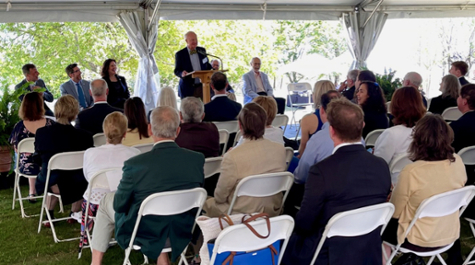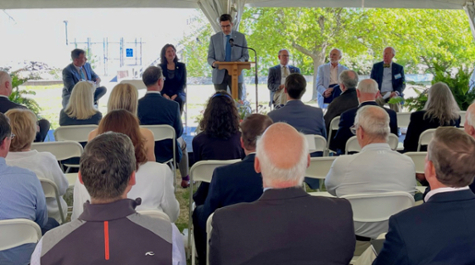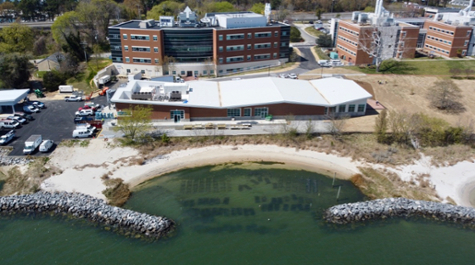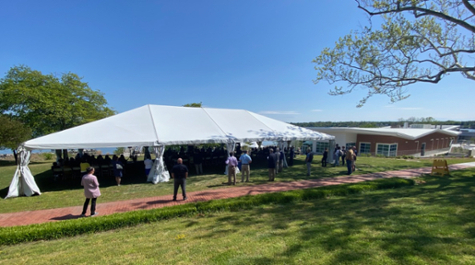VIMS dedicates Acuff Center for Aquaculture
Acuff Center for Aquaculture purpose-built to support the science of shellfish farming
Representatives from academia, state government, and the shellfish-farming community came together last Friday to dedicate the new Acuff Center for Aquaculture at William & Mary’s Virginia Institute of Marine Science.
In remarks during the dedication ceremony, Dr. Bill Walton, Acuff Professor of Marine Science and coordinator of the Shellfish Aquaculture Program at VIMS, said “The Acuff Center will soon be populated with scientists and millions of baby oysters. This beautiful new state-of-the-art facility will allow VIMS to help Virginia’s aquaculture industry solve problems and seize opportunities as well as position VIMS as a global leader in the field of shellfish aquaculture science.”
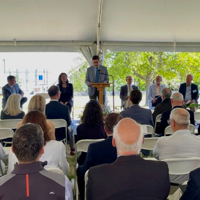 Dr. Derek Aday, VIMS Dean & Director, said “It’s always a particularly exciting day when a new building is dedicated—when the hard work and perseverance become tangible and the early dreams and imaginings are realized. Times like these create an atmosphere of excitement for those who will populate the space, anticipation for all who will benefit from it, and gratitude as we honor those for whom the new building is named. Today, that person is Mr. Marshall Acuff.”
Dr. Derek Aday, VIMS Dean & Director, said “It’s always a particularly exciting day when a new building is dedicated—when the hard work and perseverance become tangible and the early dreams and imaginings are realized. Times like these create an atmosphere of excitement for those who will populate the space, anticipation for all who will benefit from it, and gratitude as we honor those for whom the new building is named. Today, that person is Mr. Marshall Acuff.”
Marshall Acuff Jr. W&M ’62, L.H.D. ’07, a managing director at Silvercrest Asset Management LLC in Richmond, has given his time, talent, and treasure to VIMS and William & Mary for decades. A founding member and past president of the VIMS Foundation Board, he also chaired VIMS’ For the Bold campaign committee and in 2017 made a substantial commitment to advance shellfish aquaculture research at VIMS through a named professorship, endowed scholar program, and support for the now eponymous shellfish hatchery.
“It’s a vote of confidence in the work VIMS does and will do for oysters,” Acuff said. “The research has a huge impact, and the oyster hatchery will provide an economic benefit to those who work on the water.” One such waterman was Acuff’s father, an oyster harvester on Virginia’s Eastern Shore. The Acuff name honors both father and son.
Echoing the economic and cultural importance of oysters was fellow dedication speaker Mike Oesterling, Executive Director of the Shellfish Growers of Virginia. He said Virginia’s success in shellfish aquaculture depends on three factors: “First are our hard-working, innovative watermen farmers. Second is a favorable regulatory climate. Third—and why we’re all here today—is the industry’s long-standing partnership with our academic institutions. VIMS’ Eastern Shore Lab is widely regarded as the birthplace for hard clam aquaculture, and without VIMS’ Aquaculture Genetics and Breeding Technology Center, we wouldn’t have our vibrant oyster aquaculture industry.”
Virginia is the leading producer of hatchery-based shellfish on the East Coast. Cultured shellfish contribute more than $100 million to the Commonwealth’s economy each year while helping to filter Chesapeake Bay waters.
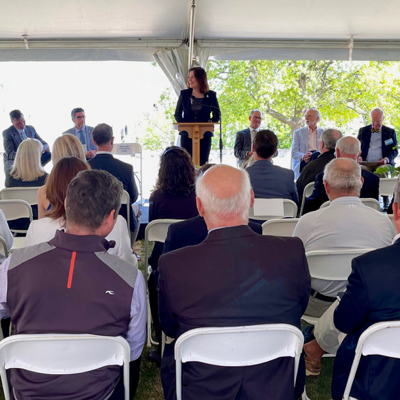
W&M President Katherine Rowe stressed the importance of clean water in her remarks. “Water is among the most critical resources over the next 50-100 years and one of the four cornerstone initiatives of our new strategic plan,” said Rowe. “The work we do here—at the Acuff Center, VIMS, and W&M—will help ensure the vitality of aquatic ecosystems in our Commonwealth and around the globe.”
The $22.7 million Acuff facility was designed by architects at Ellenzweig and Quinn Evans and built by Kjellstrom & Lee Construction of Richmond. Funding was from the Commonwealth of Virginia.
State senator T. Montgomery “Monty” Mason said “VIMS is highly respected and regarded in Richmond. I’m proud the General Assembly has funded this state-of-the-art facility so VIMS can expand on their cutting-edge work developing science that helps grow the aquaculture industry in Virginia, the United States, and the world.”
The facility
The Acuff Center for Aquaculture was purpose-built to advance the science of farming shellfish. The 22,000-square-foot facility houses a shellfish research hatchery designed to accommodate the operation of VIMS’ Aquaculture Genetics and Breeding Technology Center (ABC), plus several other research, education, and advisory teams collaborating within the institute’s recently established Shellfish Aquaculture Program.
Dr. Jessica Moss Small, ABC associate director, says “At its most fundamental level, the facility will greatly enhance ABC’s core mission. We’ll use it to create genetically distinct groups of oysters for our ongoing breeding work, as well as other grant-funded projects. For ABC, the hatchery will produce hundreds of unique groups of oysters every year, many of which will eventually go to industry as brood stock.” VIMS’ production of spawnless brood stock, pioneered by now-emeritus professor Dr. Stan Allen, was the catalyst for Virginia’s rapidly growing oyster aquaculture industry.
Small cites several features of the new facility as especially beneficial, particularly in comparison to the hatchery it will replace. Constructed in 1975, that building is now both undersized and outmoded.
Small says “The Acuff Center will provide highly filtered seawater water via computer-operated pumping and filtration systems at optimal temperatures to grow algae and oyster larvae, and lots of floor space and larval tanks so that production isn’t limited or stalled due to space constraints. It will also enable us to do all our spawning work in a single facility, creating valuable efficiencies in personnel and resources.”
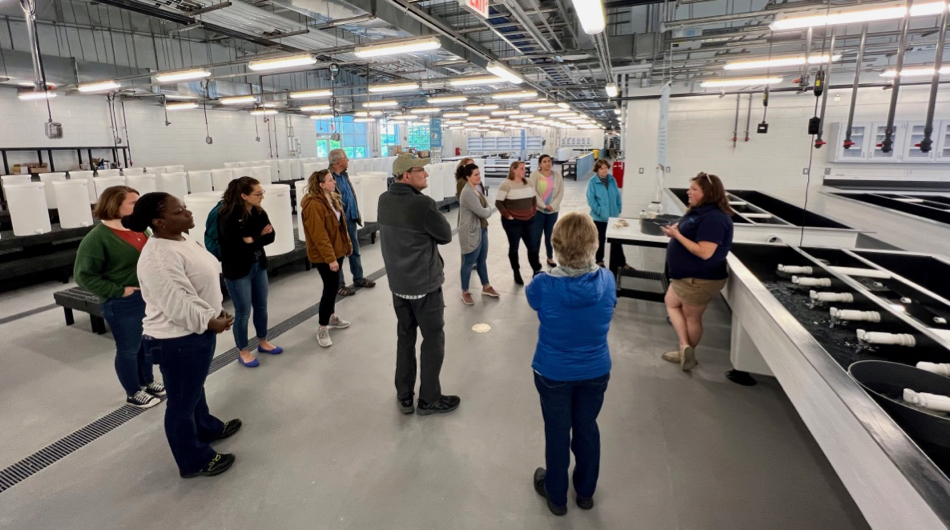 Walton is also excited to see the facility open. “The Acuff Center will allow VIMS to better serve stakeholders in several ways,” he says. “First, it will allow us to conduct experiments in systems comparable to what growers currently use, and thus position us to conduct more research at a ‘real-world’ scale. Second, it will be an ‘open-source’ hatchery available to stakeholders to see and assess new systems. Third, it will be a premier training ground for those interested in shellfish aquaculture.”
Walton is also excited to see the facility open. “The Acuff Center will allow VIMS to better serve stakeholders in several ways,” he says. “First, it will allow us to conduct experiments in systems comparable to what growers currently use, and thus position us to conduct more research at a ‘real-world’ scale. Second, it will be an ‘open-source’ hatchery available to stakeholders to see and assess new systems. Third, it will be a premier training ground for those interested in shellfish aquaculture.”
Both Small and Walton express particular enthusiasm for the collaborative opportunities the new facility will offer. “With the Acuff Center,” says Small, “we’ll be able to work side-by-side as needed with collaborators in a shared space, rather than having to shoe-horn people as in our current facilities. Also, building staff can supply things like filtered water, algae, larvae, or spawning tanks to others at VIMS, so that our expertise in ABC will be available as needed for guidance.”
Walton, like Small, sees the facility’s potential for collaboration, innovation, and leadership. “Our vision,” he says, “is that the Center will allow VIMS to work with Virginia’s shellfish aquaculture industry to solve problems and seize opportunities as well as position VIMS as a global leader in the field of shellfish aquaculture science.”


